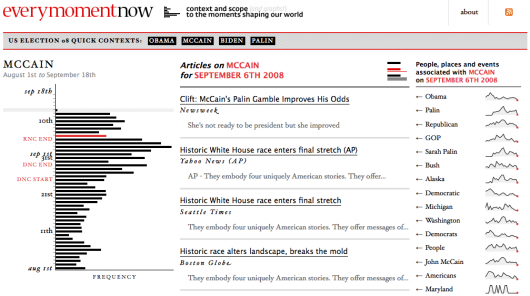I keep stumbling on rants about how media coverage of presidential candidates is uneven, biased, etc. Everymoment Now provides a way to see what’s going on with the election from the coverage (and sort of statistical) standpoint. From Craig, the developer of Everymoment:
In order to limit the scope I’ve decided to keep the focus (for now) on the 2008 US general election. It’s a timely, pertinent and, I believe, quite fascinating topic to study under this sort of data visualization lens. When all is said and done, you’ll be able to use this site to look back over the last 100 days leading up to the election and see how the shifts between candidates played out in the media. I think we all have a sense that things may get pretty nasty in the coming weeks. I feel that having a bird’s eye, hindsight view of how things went down, which stories the media focused on and how that ultimately influenced the final outcome will be an invaluable resource.
Check out spikes in coverage of the candidates or even events and locations. Lots of sparklines and lots of bar graphs very nicely organized.

While perspctv serves as election coverage dashboard, Everymoment serves as aggregator.

 Visualize This: The FlowingData Guide to Design, Visualization, and Statistics (2nd Edition)
Visualize This: The FlowingData Guide to Design, Visualization, and Statistics (2nd Edition)

These are interesting websites, however, I believe the debate centers around the fairness of coverage and not the volume. The issues surrounding the psychology of media “influence” are not simple. While volume can be important if coverage is lopsided, which these sites show is not the case, the “tone” of the coverage is also a significant statistic. If one candidate is routinely presented in a positive light and the other in a negative light then media coverage does not inform the debate but instead it influences. Intentional media influence is a dangerous game — whether it is done by state-controlled media like Russia and China or otherwise. There are a handful of text handling software packages that can evaluate “tone” of documents which, I think, would be a far more meaningful summary of the media coverage of the candidates. Of course, that evaluation may also show equal coverage which would put the debate to bed once and for all.
@Tim – definitely. that’s what statistics is all about. it’s about looking at the data, and then digging deeper trying to answer the why and trying to find as much context as possible.
Do you have any recommendations on those software packages that evaluate “tone?” I’d be interested to see those.